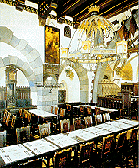|
U Fleku
The golden age of the brewery began in 1898 and lasted two or three decades. At that time the cream of the Prague intelligentsia used to go to U Fleku; the list of names would have filled pages. How this beer-hall attracted its customers more than other Prague pubs can be discovered from excerpts from Hasek's story, "My Friend Hanuska." It ends with an interesting comparison between a tramp and affluent Prague townsmen. Hanuska expressed a wish to see at least one of those "lip-smacking Czech epicures, sitting in the U Fleku pub": "… he had only one desire, just one wish to look into the source of Czech politics, to the spring of the Czech bourgeoisie." The author of a newspaper report from 1902 carried out a survey of the social composition of the customers who came to this place: "there are twelve doctors, eight writers, seven envoys, six actors, five artists, four journalists, three priests, three bathing-pool attendants, two orchestral conductors, two theatre directors, two masseurs, two accoucheuses, two noblemen and one executioner's boy. The book-binder Josef Bozetech sat in U Fleku every day and narrated the contents of all the books that had been given to him to bind. Today's U Fleku beer-hall complex comprises six rooms of differing dimensions, and two more are devoted to cabaret. The largest hall received the name Emaus (Knights' Hall); another is called Jitrnice (Sausage) owing to its shape. These halls are in the back part of the building and, as a rule, are reserved for groups or parties. If we enter the entrance corridor from the street, on the right is the Old Czech hall which is chiefly a dining room at mid-day. On the other side is the Great Hall, behind that is the Kufr (Case) and the Academy. The decor is dark, of a rustic character. It was designed according to plans by the architect Frantisek Sander during the years 1898 and 1905. Of the artists who completed both the interior and exterior frescoes the best-known is Lada Novak. The society of artists who gathered at U Fleku in 1908 elected the painter king with the title Rex Flecorum. "If beer died out, how many orphans there would be" decorates the Old Czech hall. The long garden tables are shaded by old spreading trees. From spring to autumn on Wednesdays, Fridays, Saturdays and Sundays, a traditional Czech brass band plays from the late afternoon through the evening. They haven't forgotten the souvenirs, either, which can be bought right at the entrance to the pub. U Fleku is renowned for the fact that it is the only beer-hall in central Europe which, after five or six centuries, brews and sells its own beer. Today's black beer, tasting a little of caramel, has been brewed there since 1843 from a Bavarian recipe. It is made with four kinds of malt and is not bottled nor is it exported. The average yearly consumption of beer for an annual 500,000 visitors is around 230–660 gallons of beer daily. In the summer the figure can be twice as high. The beer there does not have to be ordered, it arrives at the table without being asked for and is paid for immediately, as is the modern custom. |
